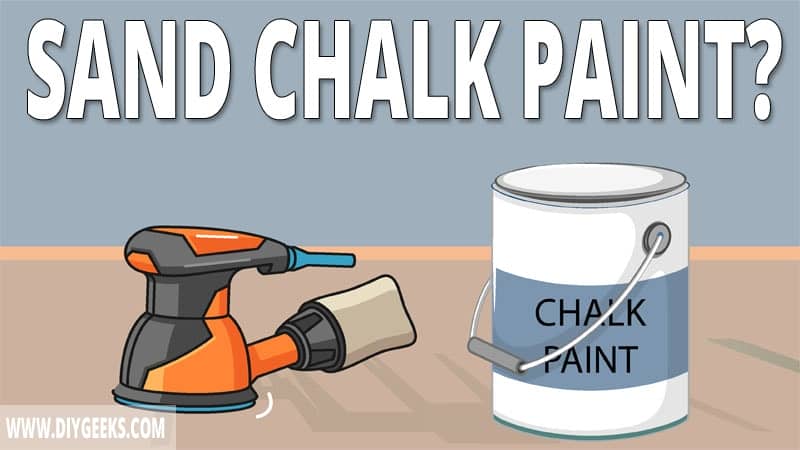You can sand before applying and between chalk paint coats to improve the paint adhesion and get a smooth finish. You don’t need to sand the chalk paint final coating unless you want a distressed finish or want to seal the paint.
To sand before applying chalk paint, use coarse or medium-grit sandpaper (40/100-grit), to sand between coats, use fine-grit sandpaper (220-grit), to sand the final coating, use extra fine-grit sandpaper (440-grit).
Do you Need To Sand Before Applying Chalk Paint?
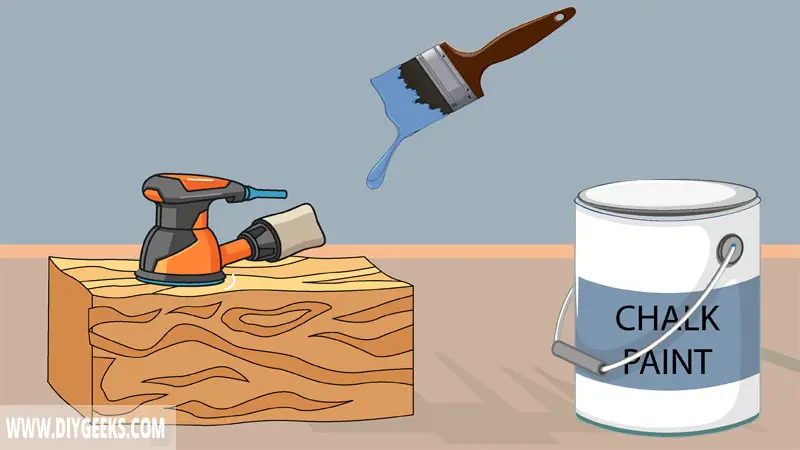
You need to sand before applying chalk paint to remove imperfections, dust, dirt, and bumps from the surface to improve the paint adhesion.
If you don’t sand the surface, the chalk paint won’t adhere properly and might peel off after a while. That’s because the imperfections, dirt, and dust, will prevent the paint from properly penetrating the surface and adhering.
If the surface is finished with oil-based paint or sealer, you must sand it before applying the paint. An oil-based paint finish won’t allow chalk paint to penetrate the surface or adhere to it.
To sand before applying chalk paint, use medium-grit sandpaper (100-grit) for bare surfaces (not finished), and coarse-grit sandpaper (40-grit) for finished surfaces.
Sanding before painting is optional if the surface is clean and doesn’t have imperfections, bumps, or dirt.
Do You Need To Sand Between Chalk Paint Coats?
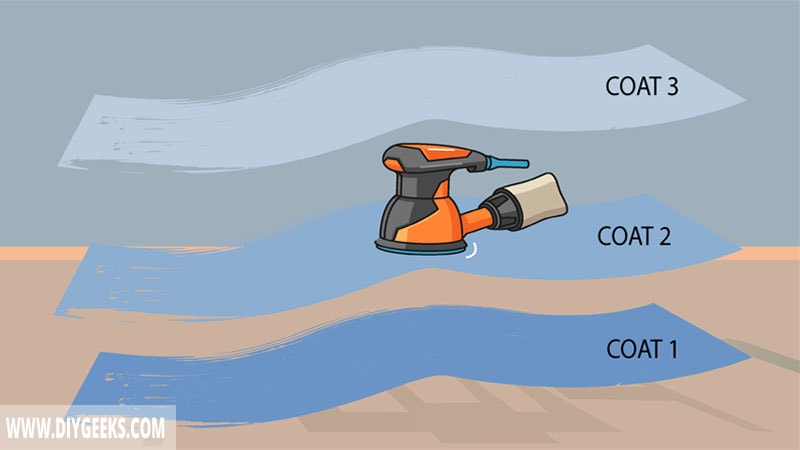
You need to sand between chalk paint coats if you want a smooth and high-quality paint finish. Sanding will remove imperfections, and flatten the coating for the next paint coat.
To sand between chalk paint coats, use fine-grit sandpaper (220-grit) as it will remove the imperfections but won’t remove (or affect) the paint coating. Don’t use coarse or medium-grit sandpaper as it will remove the paint.
You don’t have to sand between chalk paint coats if the coating doesn’t have imperfections, dust, or dirt, and is flat.
Related Read: Does Chalk Paint Scratch Easily?
How Long Must Chalk Paint Dry Before Sanding?
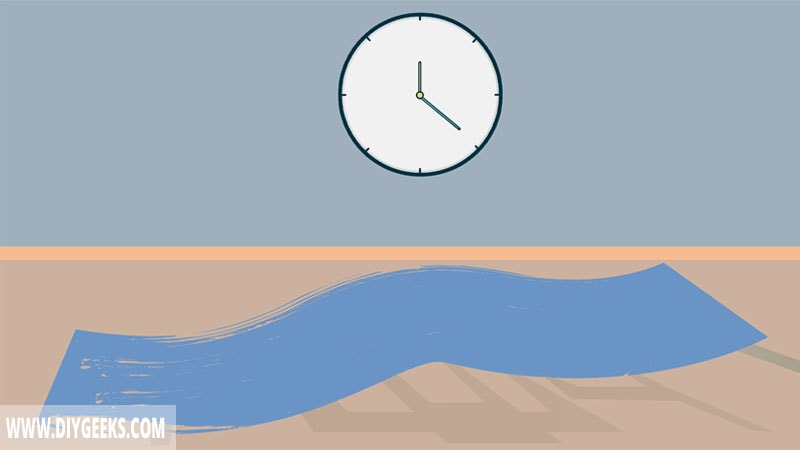
Chalk paint must dry for around 30 minutes before sanding. This gives its coating enough time to harden and dry to support the abrasive side of the sandpaper
The exact dry time depends on the humidity levels, the number and thickness of the coats, and room temperature. For instance, the paint takes longer to dry during low temperatures and high humidity levels.
Chalk paint dries through evaporation — the paint solvent (water) must evaporate from the coating for it to become dry and rigid. Chalk paint is water-based and uses water as its paint solvent, since water evaporates fast, the paint also dries fast.
If you sand chalk paint too soon, the finish will get removed as it isn’t strong or dry enough to withstand the abrasive side of the sandpaper.
To know if chalk paint is dry enough for sanding, use the sandpaper trick. Swipe ultrafine-grit sandpaper across the finish (after 30 minutes); if the sandpaper gets clogged, the paint isn’t dry enough. If the sandpaper swipes with ease (doesn’t get clogged), the paint is ready to be sanded.
How To Dry Sand Chalk Paint?
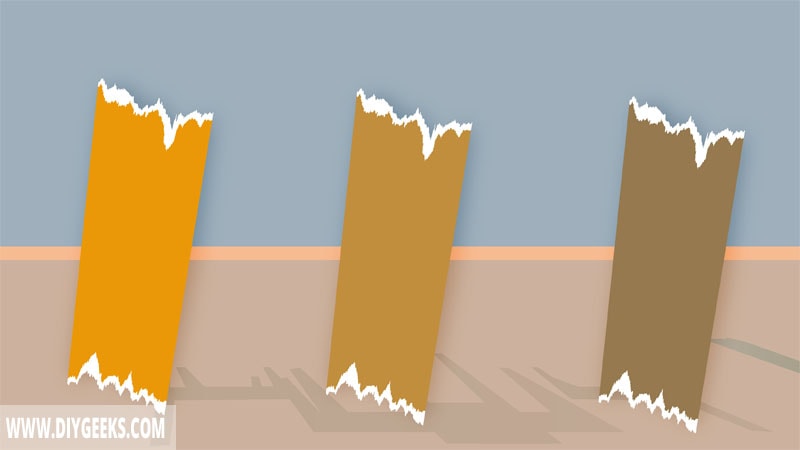
To dry sand chalk paint, do the following things.
- Clean the Finish.
- Sand the Chalk Paint.
- Vacuum the Dust.
- Inspect the Finish.
The tools you need for this project are listed below.
- Fine-grit sandpaper (220-grit), or extra fine-grit sandpaper (440-grit), or sanding block.
- Soft Brush
1. Clean the Finish
Clean the finish with a soft brush or lint-free cloth to remove dust, debris, and filth that can prevent proper sanding.
Chalk paint isn’t durable, so don’t use tools that can abrade or scar the finish.
2. Sand the Chalk Paint
To sand chalk paint, do the following things.
- Use extra fine-grit sandpaper (440-grit).
- Swipe the sandpaper across the coating.
- Don’t apply pressure while sanding.
- If sanding between coats, move the sandpaper back and forth over the coating to create tiny scratches.
- If sanding the final coat, don’t move the sandpaper back and forth repeatedly. Instead, sand it with one swipe.
Don’t sand the final coat repeatedly because you aren’t trying to create holes or pores. Instead, you want to make the final coating as smooth as possible.
3. Vacuum The Dust
After sanding the chalk paint finish, remove the dust by using a vacuum. Sanding creates a lot of dust that can prevent paint adhesion.
Related Read: How To Paint Over Chalk Paint?
4. Inspect The Finish
Inspect the finish after sanding and cleaning it. If the coating is smooth enough, don’t sand it anymore. If the coating has bumps or imperfections, sand it with fine-grit sandpaper (220-grit).
The advantages of dry sanding chalk paint are listed below.
- You can re-coat the paint immediately after dry sanding.
- The finish won’t get removed.
The disadvantages of dry sanding chalk paint are listed below.
- It produces a lot of dust.
- The sanding result isn’t as smooth.
How To Wet Sand Chalk Paint?
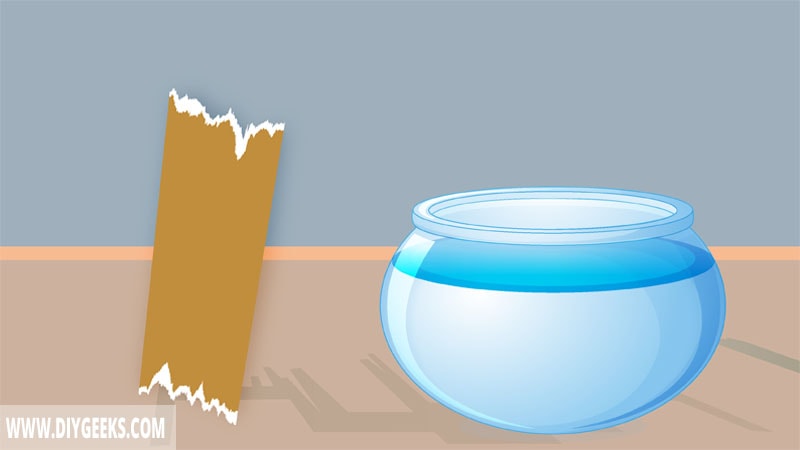
To wet sand chalk paint, do the following things.
- Prep the Paint Finish and Sandpaper.
- Wet Sand the Chalk Paint.
- Let the Paint Dry.
Wet sanding chalk paint is different from dry sanding it. To dry sand the paint, the coating must dry until it hardens and the paint solvent evaporates. To wet sand the paint, the finish must cure (fully dry) because water can remove it.
The tools you need for this project are listed below.
- A Bowl Of Water
- Waterproof sandpaper Or Sanding Sponge
- A Dry Towel
1. Prep the Paint Finish and Sandpaper
Prep the paint finish by cleaning it with a clean rag and wiping the dust off it. Prep the sandpaper by dipping it into water.
To prep a waterproof sandpaper, do the following things.
- Dip the waterproof sandpaper into water.
- Wait 2 minutes.
- Take the waterproof sandpaper off the water.
- Squeeze it to remove excess water.
- The sandpaper must be damp, not dripping wet. If it’s dripping wet, it will damage the paint.
2. Wet Sand the Chalk Paint
To wet sand the chalk paint lay the abrasive side of the waterproof sandpaper over the finish and move it lightly. Don’t apply too much pressure as the finish can get removed.
While sanding, dust will start to stick to the sandpaper. Sand until the waterproof sandpaper accumulates too much dust (where you can’t sand anymore), and then stop, dip the sandpaper into the water again, and start again. You must do this often.
3. Let The Paint Dry
After wet sanding the chalk paint, leave it to dry for a few minutes. When the paint dries, inspect the finish and check if you have a desired level of smoothness. If the finish isn’t smooth enough, wet sand it again.
The advantages of wet sanding are listed below.
- Wet sanding doesn’t produce a lot of dust
- It creates a smoother finish.
The disadvantages of wet sanding are listed below.
- The paint can get washed off if you use too much water.
- You must wait until the paint cures before wet sanding (which takes longer).
- You must wait until the coat dries to re-coat it.
Do You Need to Sand Chalk Paint Final Coating?
You need to sand the chalk paint final coating if you want a distressed finish or if you want to seal it. You shouldn’t sand the final chalk paint coating if you don’t want a distressed finish or seal it, as it will make the finish weaker and prone to damage.
To sand the final chalk paint coating, use extra fine-grit sandpaper (440-grit). This sandpaper will lightly remove imperfections, bumps, and brush marks, but won’t damage the finish.
Don’t use coarse or medium-grit sandpaper to sand the final coating as it will remove most of it, making it weaker and prone to damage.
Does Sanding Damage a Chalk Paint Finish?
Sanding doesn’t damage a chalk paint finish if you use the right type of sandpaper and grit. However, you can remove or damage the chalk paint finish if you use the wrong type of sandpaper, grit, or sanding method.
Sandpapers come in different grits. For instance, ultrafine-grit sandpaper is made to smoothen a surface and remove imperfections. On the other hand, coarse-grit sandpaper is made to remove a finish from the surface. So, if you use the right type of sandpaper, you won’t damage the finish.
Different sandpaper grits to sand chalk paint are listed below.
- Before applying chalk paint, use coarse-grit sandpaper (40-80 grit).
- For between coats of paint, use fine-grit sandpaper (200-grit).
- For the final coat of the paint, use ultrafine-grit sandpaper (440-grit).
